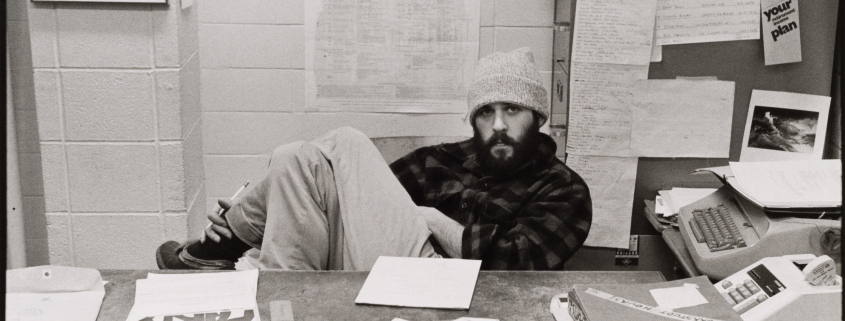Re:Collection John Banasiak on Phil Block
Visitors to Light Work’s website are invited to explore thousands of photographic works and objects from the Light Work Collection in our online database that expands access of work by former Light Work artists to students, researchers, and online visitors. Our Re:Collection blog series invites artists and respected thinkers in the field to select a single image or object from the archive and offer a reflection as to its historical, technical, or personal significance.
Today we’re sharing a reflection on John Banasiak’s image of Light Work co-founder Phil Block. In unique Re:Collection twist, Banasiak, the portrait image-maker, is also the author, offering contemplative insights on this early organization champion and the impact of artist residency on his photography practice.
In 1977, I had the good fortune of being one of Light Work’s first artists-in-residence. Invited by Phil Block and Tom Bryan, I spent the month of October printing some of the negatives from my ongoing series of nightwork and interacting with a community of people who appreciated the beauty and poetic language of photography. I also had the honor of having my work appear in the first issue of Contact Sheet.
I came from Chicago in an Oldsmobile Delta ‘88, a “Drive Away Car” I was hired to drive and drop off at a car dealership somewhere in Syracuse. I parked in front of Light Work on Waverly, put out my cigar, walked up the front steps, and into Phil Block’s office. It was like I was reuniting with a brother or cousin I hadn’t seen in a long while. His friendly, laid-back, good-humored nature made me feel as if I had known him all my life. He happened to know the car dealership that I needed to get to, so we drove out and back and had some great talks and told each other a bunch of good stories. Soon they showed me around the facility and introduced me to a few of the people who were there—Karl Baden, Dave Broda, Marion Faller, Bill Gandino, Peter Glendinning, Judith Ivry, and others. Tom Bryant would show up occasionally and drive me around to some of the interesting sites of the surrounding countryside.
Within a day or two, I was mixing up some Selectol in the back darkroom and printing from my stack of 4×5 negatives, occasionally stepping out in the hall to dry my test strips, sipping Pelican Punch tea from the food co-op just down the hall from the darkroom, and talking with some of the students and photo addicts who hung out in the studio.
Along with having the opportunity to print, I also explored the area and gathered some new work as I wandered through the neighborhoods, strolled the boulevards (Genesee), and parks (Thornden) of the area. I had falafels at King David’s, cheesecake from the Snow Flake Bakery, shots and beer with the locals at the Orange. I danced to the tropical country music of Dan Hicks and his Hot Licks at the Jabberwocky across the street from Light Work. I ate dinners of crustless quiche with Susan Narucki, a beautiful woman with a beautiful voice who, as a work/study, took care of the Light Work darkroom and went on to international acclaim as a Grammy-winning soprano for her recording of George Crumb’s “Star Child” in 2000. I took evening swims in the University pool. Phil and I occasionally went out at night and listened to the local music. There was a great diversity in music available on campus, but Phil and I both liked jazz and blues so we hit some of those places. Phil had a stand-up bass that he sometimes played at home while listening to Thelonious Monk, or Coltrane, and I thought he was pretty good.
The mix and steady flow of photographers and visiting artists though those days at Light Work always provided an infusion of good creative thought and energy. Light Work was very connected with what was going on at the Everson Museum, as well as what was happening at Syracuse University’s art school and galleries. Clement Greenberg lectured one evening, Bill Owens talked about his book Suburbia, Marion Post Wolcott reflected on her time with the WPA, and one afternoon Michael Jennings read some of his poetry at the Dorothea Lange exhibition at the Everson. It was a stimulating time and I knew I would have a difficult time leaving. Former teachers of mine, Charles Harbutt and Joe Jachna, were there a few months before me. Cal Kowal was coming as an artist-in-residence just after me—I had worked with him at Ox-Bow Summer School of Art the year before and was going to miss him by just a couple of months.
My time at Light Work solidified my enjoyment and affection for the college environment and the creative energy that can emerge and grow there. After I left at the beginning of November, I decided to think more about teaching and being a part of a creative community in a college environment. Soon after leaving Syracuse and Light Work, Phil called me and asked me if I might be able to get away from Chicago to take over a one-year position teaching photography up at SUNY Oswego. Returning to upstate New York sounded great. I called Tom Eckersley, the chair in Oswego’s College of Art, and the next thing I knew, I was loading up a U-Haul and heading to Oswego.
My year in Oswego was inspirational. Occasionally it included trips down to Syracuse (via Heid’s hot dog stand in Liverpool) to visit Phil and Light Work. It also began a chain of events that led to alternative process workshops at Auckland University and Christchurch University in New Zealand and eventually to a position in the College of Fine Art at the University of South Dakota in Vermillion where, this August, I am heading into my 42nd year of teaching an ever-changing mix of the old and new processes and visual dialects of photography.
Phil Block and Light Work have played a significant part in my growth and development as an artist and as an educator, and I will always feel affection and gratitude for all that they have generously given me. One final thing that I’d like to mention. When I did drive out to Oswego to teach for that year back in 1978, one of the first photography students I met when I was putting together my classes was a talented young artist by the name of Paul Pearce. I see now that he will be a Light Work Grants recipient for this coming year. His work continues to be personal, revealing, and meaningful. I look forward to seeing some of his new work, and I wish him the best, and I hope that he has a creative, productive, and inspirational time at Light Work.
Find more of John Banasiak’s work online here.
Explore the Light Work Collection online at http://collection.lightwork.org



